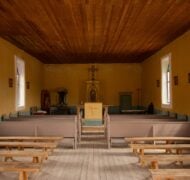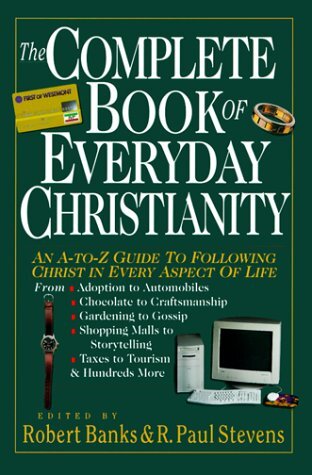Church, Small
Book / Produced by partner of TOW
Small congregations are of different kinds—rural, fringe and urban. By virtue of their integration into and reputation within the community, some are still the dominant church in their area. In some places it is their denominational profile that stands out. Others have developed a distinctive identity and style. Normally they are known for the quality of their communal life rather than of their corporate worship. They are more likely than large congregations to resist change and innovation. They tend to give more attention to continuity, their place of meeting and a social agenda. Most small churches have a relatively stable or declining membership.
In a growing number of places it is very easy for small churches to feel second-rate compared to larger ones. Since these days success is mostly measured in numbers, members of small churches—especially in cities—can easily feel they are lacking. Yet in most parts of the world the majority of congregations are small. This is not only true in relatively unchristianized countries like China or post-Christian societies such as Europe. Even in the United States, about half of all Protestant congregations average fewer than seventy-five people. In fact nearly one-fifth of all United Methodist churches, one-seventh of all Presbyterian churches and one-tenth of all Baptist and Episcopal churches in the United States have fewer than twenty-five members.
Their History and Extent
Historically, for the most part, churches have not been large. The earliest Christian gatherings were small enough to fit into a home or apartment. Though this changed when Christianity became the state religion in the fourth century, most churches were not that large, particularly in rural areas where the majority of the population lived. The large cathedrals built during the Middle Ages mostly supplemented the life of local churches in a particular region. While the Reformation reinvigorated church life and attracted larger congregations in some cities, most people still lived in the countryside and attended small churches. Later renewal movements, such as Methodism, were originally also strongest in villages and towns. Most congregations in North America began their institutional life as small churches. Also, the main models for congregations until recently included only one paid staff, one part-time staff or one volunteer-led staff, all of which are oriented to small churches.
As the Industrial Revolution expanded the size of cities and evangelicalism effected renewal in many places, larger preaching houses began to appear. This became easier with the advent of streetcars and automobiles. As the driving population has increased (see Automobile; Commuting), some very large churches have appeared in newer suburbs and cities where freeways converge. Now megachurches of several thousand members have become a fixed feature of the religious scene. Even so, these still serve about one-sixth of the total churchgoing population. About one-half attend medium-sized or larger congregations, and the remaining third are in small churches. Increasingly people are preferring to attend a church not too far from where they live, at least in their region if not in their locality.
Some Advantages and Disadvantages
In principle, though not always in fact, small churches have many advantages. They tend to be less impersonal, giving members and their children a better chance of knowing and supporting one another. As a recent survey of Southern Baptist congregations indicated, they tend to generate greater commitment: people in them give more of their money and time than members of large congregations. Since in smaller churches there are fewer people to undertake the work of the church, members develop a greater sense of responsibility and leadership. They tend to be more missionary-minded: proportionally they give more to, and offer themselves more to train for, Christian work overseas.
Small churches also have potential disadvantages. While members of small churches may know one another more, for this reason they may also have stronger conflicts. Unless resolved, these can easily become long-lasting feuds between different factions in the church. While in small churches there is more opportunity for people to take responsibility and exercise leadership, sometimes it is also easier for them to hold the reins too long and restrict the contribution of others. Unless the church is made up of people who are relatively mobile, new members can sometimes find it more difficult to become fully accepted. Also, in a small congregation unhelpful gossip may exercise a strong sway.
None of these need to happen. They are not inherent in the small size of a church. They are simply the reverse side of the advantages just mentioned. For despite the widespread perception that small churches are more likely to be in-centered and cliquish, often this is far from the case. Whether a congregation is inward-looking or outward-looking has little to do with size: it depends on people’s—and the pastor’s—attitude. In fact, strong mission-oriented denominations like the Mennonites and committed socially conscious ones like the Quakers have generally been made up of smaller congregations. There is also a widespread belief that larger churches with well-known teacher-pastors produce members who know more about their faith and apply it more consistently to their lives. Surveys across a range of denominations by the Search Institute in Minneapolis show that this is just not the case.
Their Possibilities and Challenges
There is no doubt that some small churches are at risk, especially those made up of first-generation immigrants, those who no longer have a resident pastor and new mission churches that never grow beyond around forty people. But small churches are not vulnerable in general. While it is often felt that small churches cannot serve their members or communities as well as large churches, in most respects this is highly doubtful. Where it is the case, there are ways of dealing with the situation. We do well to remember that down through the centuries the small church has been a highly effective instrument for producing mature believers and Christian leaders. There is no reason to believe that this cannot be the case today. God managed to do this without the array of buildings, organizations and programs that most congregations today feel are necessary. Where parents take the primary responsibility for educating their children in the Christian faith, where strong relationships are built with adults in the congregation as well as with peers, where intergenerational small groups replace groups segmented by sex, age and interest, the nurture and equipping of church members is at least as strong as that in the largest program-oriented congregations and in many cases is actually stronger.
Limits on what a small church can achieve can be overcome through working cooperatively with other local churches or by participating in wider community activities. For example, some small churches combine forces to feed the hungry, shelter the homeless, help unemployed people find work, teach literacy skills and so on. It is also possible for small churches to organize occasional common services or a combined youth program, evangelistic outreach or vacation Bible school. Also, members of a small church can join local community movements involved in service, bringing justice or protecting the environment rather than feel they must create their own structures to fulfill such objectives. Small churches can also partner with particular local institutions and also encourage members to become involved in community choirs, societies or other cultural activities rather than set up parallel church-based ones. Too many churches unnecessarily duplicate what is being done elsewhere or could be better done collaboratively.
In spite of all this, small churches are in for an increasingly difficult time. With the trend towards megachurches on the one hand and house churches on the other, small churches may find themselves caught in the middle. This would be a great pity. Megachurches might be more effective if they multiplied smaller congregations throughout a city and held only occasional huge meetings, that is, if they turned themselves into a constellation of smaller churches. House churches can be fully effective only if they cluster together in congregations, still relatively small, that meet regularly, perhaps monthly.
In the coming years small churches will need to find ways of opening up more to new members, without feeling that numerical growth is the only criterion of fidelity to the gospel. To remain vital, they should continue focusing on what they do best: building community, especially among the lonely and unchurched, and serving their immediate neighborhoods, which sometimes are increasingly multicultural. They have much to offer families, mature adults and lifestyle enclaves. One possibility for them is to develop house churches so that they can attain greater relational depth and collaborate more systemically with other small churches in evangelism, education, youth work and mission, thus having access to larger resources and having a more concerted influence on their neighborhoods and cities. In some rural areas small congregations could almost turn themselves into home churches within their denomination and so be less dependent on itinerant pastors or costly buildings. Looked at as a challenge rather than a problem, the present uncertainty surrounding small churches can lead to very creative experiments and opportunities.
» See also: Church
» See also: Church in the Home
» See also: Fellowship
References and Resources
S. R. Burt and H. A. Roper, Raising Small Church Esteem (Washington, D.C.: Alban Institute, 1992); M. Breen with S. Fox, Growing the Smaller Church (London: Marshall Pickering, 1992); C. S. Dudley and J. M. Walrath, Developing Your Small Church’s Potential (Valley Forge, Penn.: Judson, 1988); L. Schaller, The Small Membership Church: Scenarios for Tomorrow (Nashville: Abingdon, 1994).
—Robert Banks





